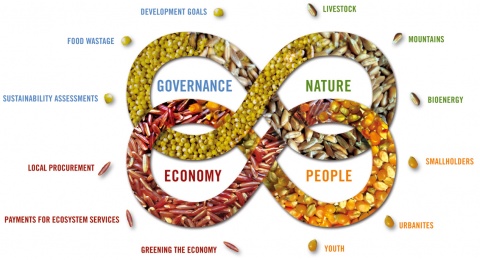In the view of increasing environmental concerns, sustainability has come into the foreground over the past decade and several sustainability assessment tools have been developed. Critiques claim though, sustainability is only an empty phrase because of frequent unreflective usage and overstretching of the concept - often solely for commercialization purpose. Nonetheless, sustainability assessment is more important than ever due to ongoing environmental degradation, socioeconomic worsening or even crises related to agriculture and food systems.
The concept of “sustainability” has first been presented by United Nations General Assembly in 1987 and then refined by the Food and Agriculture Organization (FAO). At the very beginning of the sustainability debate, the concept was mainly associated with environmental soundness to improve the management and conservation of natural resources. In order to acknowledge the holistic character of sustainability focused on food systems, the FAO developed the guidelines for Sustainability Assessment of Food and Agriculture Systems[1] (SAFA).
Already in 2009 the Food and Agriculture Organization (FAO) started to work on a Sustainability framework to fill the concept with substance and to develop a generally valid definition of sustainability for the agriculture and food sector. Therefore, FAO invited stakeholders to share their opinion during a 5-week online-forum to discuss scope and indicators for Sustainability Assessment of Food and Agriculture Systems (SAFA). In total, 246 participants from 61 countries participated and their contributions formed the basis for a synthesis report. The next step was a stakeholder survey, which was conducted in cooperation with the Swiss College of Agriculture and the Research Institute for Organic Agriculture (FiBL). In addition to the survey, further discussions with representatives from industry and science took place during international conferences and meetings. The results obtained during this process were further refined by an extensive screening of sustainability standards, indicator systems, initiatives and regulations underpinned by and in depth-literature research. All together resulted in a first draft of the SAFA guidelines.
Thereupon a second forum was opened to allow and integrate stakeholder’s comments on the first draft. In addition, a multi-stakeholder expert meeting was organized to discuss concern and key issues before publishing the first version of the SAFA guidelines in June 2012. This version was tested in 30 different settings around the world and lessons learned from testing were shared during a practitioners and partner workshop in March 2013. After this workshop, SAFA guidelines were released in July 2013 and underwent a final peer-review process.
 SAFA guidelines are grouped in four dimensions of sustainability: good governance, environmental integrity, economic resilience and social well-being. These dimensions contain 21 sustainability themes, which split up into 58 subthemes and the corresponding sustainability goals. Although the subthemes are clearly defined, at the same time they are nested and interrelated to each other. “SAFA is a holistic global reference framework for the assessment of sustainability along agriculture, forestry and fisheries value chains.” (FAO, 2014). It is a suitable framework for comparing different farm types and for identifying further potential for improvements and providing policy recommendations.
SAFA guidelines are grouped in four dimensions of sustainability: good governance, environmental integrity, economic resilience and social well-being. These dimensions contain 21 sustainability themes, which split up into 58 subthemes and the corresponding sustainability goals. Although the subthemes are clearly defined, at the same time they are nested and interrelated to each other. “SAFA is a holistic global reference framework for the assessment of sustainability along agriculture, forestry and fisheries value chains.” (FAO, 2014). It is a suitable framework for comparing different farm types and for identifying further potential for improvements and providing policy recommendations.
Nowadays, SAFA is a recognized and globally applicable tool for comprehensive sustainability assessment. It has been developed for enterprises, whether large scale food companies or small scale producers, involved with the production, processing, distribution and marketing of food products, that they develop a clear understanding of the underlying concept of sustainability. SAFA guidelines provide a transparent framework for assessing sustainability along the food value chains. With the surveys based thereon, strengths, weaknesses and progress of sustainability performance of agriculture and food production can be tackled and can help to identify deficiencies of and to find strategies for improving sustainability performance. The SAFA framework has been the source of inspiration for developing the SMART farm tool, which was developed by the Research Institute of Organic Agriculture (FiBL) for comprehensive sustainability assessment at farm level.
The SAFA framework, including the guidelines for application and the description of indicators, and the SMART farm tool provide a solid basis for developing an Eco-farm Assessment Tool for the CAPTIVATE project. The project is funded under the Erasmus + program of the European Union, is dedicated to knowledge transfer and vocational training of farmers and agricultural advisors related to the current EU strategic lines, such as the Green Deal, Farm to Fork Strategy and Organic Action Plan. One of the CAPTIVATE’s main objectives is that farmers better understand conditionality, eco-scheme and rural development regulations, they choose and participate in the certain schemes with more responsibility and awareness, carrying out the new CAP measures more effectively.
Authors: Leitgeb, F. and Petrasek, R.
[1] https://www.fao.org/nr/sustainability/sustainability-assessments-safa/en/



